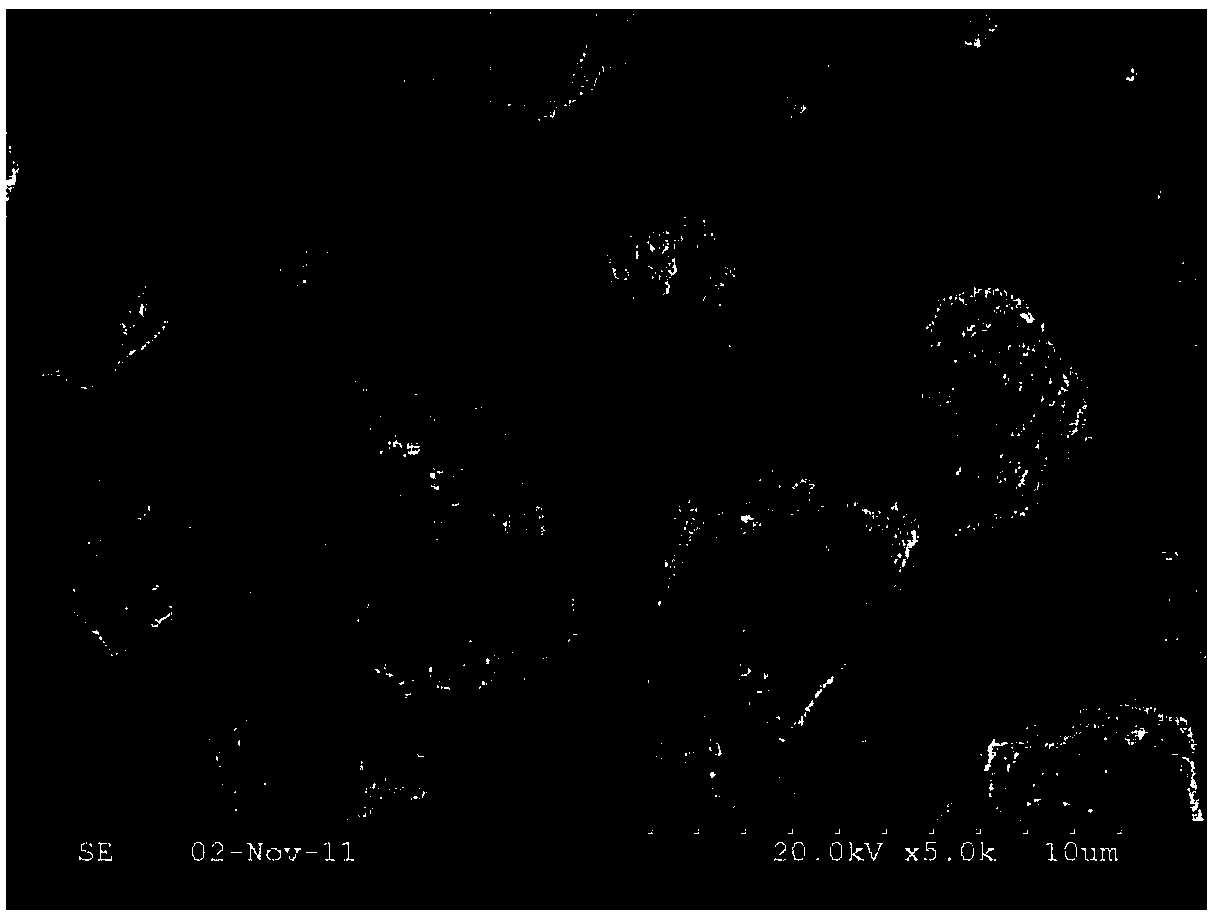Lithium-rich manganese-based material coated with lithium aluminum titanium phosphate and preparation method of lithium-rich manganese-based material
A lithium titanium aluminum phosphate, lithium-rich manganese-based technology, applied in structural parts, electrical components, battery electrodes, etc., can solve the problems of voltage platform discharge capacity attenuation, low Coulomb efficiency, and microcracks on the surface of positive electrode materials, etc., and achieve excellent magnification performance, excellent coulombic efficiency, and the effect of excellent cycle performance
- Summary
- Abstract
- Description
- Claims
- Application Information
AI Technical Summary
Problems solved by technology
Method used
Image
Examples
Embodiment 1
[0030]S1: Add 100mL of deionized water into a 250mL high-necked beaker, then add 25g of manganese sulfate, 5.4g of nickel sulfate and 5.8g of cobalt sulfate at a stirring speed of 500 rpm, and fully disperse them; then Under the stirring condition of 1500 rpm / min, add dropwise an appropriate amount of ammonia water and sodium hydroxide mixed solution in the above solution, wherein the concentration of sodium hydroxide is 5mol / dm 3 And the concentration of ammonia water is 1mol / dm 3 , so that the pH value is at 11; then the above suspension is filtered by suction, and baked in a vacuum oven at a temperature of 100 ° C for 6 hours to obtain a hydroxide precursor;
[0031] S2: Fully mix the precursor obtained above with the lithium source, and add B at the same time during the mixing process 2 o 3 as a flux; then put the above mixture into the muffle furnace, calcined at 800°C for 10h, and the heating rate was 4°C / min, after the calcined was cooled, rinse it with deionized wate...
Embodiment 2
[0035] S1: Add 100mL of deionized water into a 250mL high-necked beaker, then add 25g of manganese sulfate, 5.4g of nickel sulfate and 5.8g of cobalt sulfate at a stirring speed of 500 rpm, and fully disperse them; then Under the stirring condition of 1500 rpm / min, add an appropriate amount of ammonia water / sodium hydroxide mixed solution dropwise to the above solution, wherein the concentration of sodium hydroxide is 5mol / dm 3 And the concentration of ammonia water is 1mol / dm 3 , so that the pH value is at 11; then the above suspension is filtered by suction, and baked in a vacuum oven at a temperature of 100 ° C for 6 hours to obtain a hydroxide precursor;
[0036] S2: Fully mix the precursor obtained above with LiOH at a molar ratio of 1:1.42, then send the mixture of precursor and LiOH into a muffle furnace, and calcinate at 800°C for 10h, with a heating rate of 4 ℃ / min, after the calcined product is cooled, wash it with deionized water four times, then put it into an ove...
Embodiment 3
[0041] S1: Add 100mL of deionized water into a 250mL high-necked beaker, then add 25g of manganese sulfate, 5.4g of nickel sulfate and 5.8g of cobalt sulfate at a stirring speed of 500 rpm, and fully disperse them; then Under the stirring condition of 1500 rpm / min, add an appropriate amount of ammonia water / sodium hydroxide mixed solution dropwise to the above solution, wherein the concentration of sodium hydroxide is 5mol / dm 3 And the concentration of ammonia water is 1mol / dm 3 , so that the pH value is at 11; then the above suspension is filtered by suction, and baked in a vacuum oven at a temperature of 100 ° C for 6 hours to obtain a hydroxide precursor;
[0042] S2: Fully mix the precursor obtained above with the lithium source, and add KCl as a flux during the mixing process; then send the above mixture into a muffle furnace, and calcinate at 800°C for 10h, and the heating rate is 4°C / min, after the calcined product is cooled, rinse it with deionized water four times, ...
PUM
 Login to View More
Login to View More Abstract
Description
Claims
Application Information
 Login to View More
Login to View More - R&D
- Intellectual Property
- Life Sciences
- Materials
- Tech Scout
- Unparalleled Data Quality
- Higher Quality Content
- 60% Fewer Hallucinations
Browse by: Latest US Patents, China's latest patents, Technical Efficacy Thesaurus, Application Domain, Technology Topic, Popular Technical Reports.
© 2025 PatSnap. All rights reserved.Legal|Privacy policy|Modern Slavery Act Transparency Statement|Sitemap|About US| Contact US: help@patsnap.com


